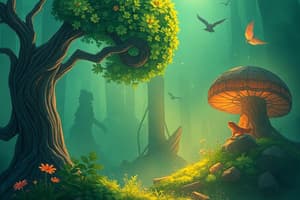Podcast
Questions and Answers
What is a primary function of predator-prey relationships in an ecosystem?
What is a primary function of predator-prey relationships in an ecosystem?
- To create cooperative groups among species
- To reduce competition for resources
- To increase the reproductive rates of predators
- To maintain a balanced food chain (correct)
In competitive relationships, what do organisms compete for?
In competitive relationships, what do organisms compete for?
- Limited resources necessary for survival (correct)
- Social dominance within groups
- Food sources and mates exclusively
- Territorial expansion and habitat diversity
How do cooperative relationships benefit species like elephants and squirrel monkeys?
How do cooperative relationships benefit species like elephants and squirrel monkeys?
- Through shared responsibility in nurturing and protection (correct)
- By enhancing individual foraging success in isolation
- By ensuring genetic diversity through mating
- Through territorial control over specific environments
What potential negative impact can competition have on younger trees?
What potential negative impact can competition have on younger trees?
What role do predators play in regulating prey populations?
What role do predators play in regulating prey populations?
Which of the following describes commensalism?
Which of the following describes commensalism?
What is an example of mutualism?
What is an example of mutualism?
In a parasitic relationship, which statement is true?
In a parasitic relationship, which statement is true?
Why do some species engage in symbiotic relationships?
Why do some species engage in symbiotic relationships?
What type of interaction occurs between the barbel fish and hippos?
What type of interaction occurs between the barbel fish and hippos?
Which of the following best defines symbiosis?
Which of the following best defines symbiosis?
What characteristic distinguishes epiphytes in terms of their relationship with trees?
What characteristic distinguishes epiphytes in terms of their relationship with trees?
In what way do the clownfish and sea anemones uniquely benefit from each other?
In what way do the clownfish and sea anemones uniquely benefit from each other?
Flashcards
Symbiosis
Symbiosis
A close, long-term relationship between two species that usually involves an exchange of food or energy.
Commensalism
Commensalism
A symbiotic relationship that benefits one species but does not harm or benefit the other.
Parasitism
Parasitism
A symbiotic relationship that benefits one species and harms the other.
Mutualism
Mutualism
Signup and view all the flashcards
Epiphyte
Epiphyte
Signup and view all the flashcards
Parasite
Parasite
Signup and view all the flashcards
Host
Host
Signup and view all the flashcards
Symbiotic relationship
Symbiotic relationship
Signup and view all the flashcards
Cooperative Relationships
Cooperative Relationships
Signup and view all the flashcards
Predator-Prey Relationships
Predator-Prey Relationships
Signup and view all the flashcards
Predator-Prey Balance
Predator-Prey Balance
Signup and view all the flashcards
Competition
Competition
Signup and view all the flashcards
Competition Examples
Competition Examples
Signup and view all the flashcards
Study Notes
Lesson Objectives
- Predict patterns of interactions among organisms across multiple ecosystems.
Interactions Within Ecosystems
- Students will use a science probe to assess prior knowledge on relationships between organisms.
- The activity, "What's the relationship?" will help uncover student preconceptions through a formative assessment.
- Students will investigate a cleaner shrimp and a moray eel relationship.
Symbiotic Relationships
- Symbiosis is a close, long-term relationship between species, often involving an exchange of food or energy.
- Symbiotic relationships form when organisms live in direct contact.
- Some species have extremely close relationships, always living together.
- Barbel fish and hippos have a symbiotic relationship: the fish follow and groom the hippos to eat parasites and then are rewarded with food scraps in return.
Types of Symbiotic Relationships
- Commensalism: One species benefits while the other is neither harmed nor helped. An example is epiphytic plants growing on trees, receiving sunlight, while the trees are unaffected.
- Parasitism: One species benefits (the parasite) while the other is harmed (the host). An example is the hunting wasp larvae that lay eggs in a spider, eating it after hatching.
- Mutualism: Both species benefit from the interaction. An example is clownfish and sea anemones living together: the clownfish receive protection from predators and the anemone receives nutrients from the clownfish's waste.
Additional Relationships in Ecosystems
- Cooperative Relationships: Organisms cooperate to help each other, like elephants raising their young and watching for predators, or squirrel monkeys cooperating in groups when hunting for food or watching for danger.
- Predator-Prey Relationships: One organism (predator) eats another (prey). An example is an osprey catching a fish, which helps keep prey populations healthy and in check.
- Competitive Relationships: Organisms compete for the same resources like sunlight (trees) or food (wolves and ravens).
Homework
- Investigate relationships in communities by examining various examples.
- Describe the characteristics observed in each example.
- Complete a lesson check on interactions within ecosystems.
Studying That Suits You
Use AI to generate personalized quizzes and flashcards to suit your learning preferences.
Related Documents
Description
Explore the complex interactions within ecosystems and the types of symbiotic relationships that exist among organisms. This quiz will assess your understanding of how various species, such as cleaner shrimp and moray eels, engage with each other and the benefits they provide in these relationships. Test your knowledge on the dynamics of commensalism and other forms of symbiosis.




